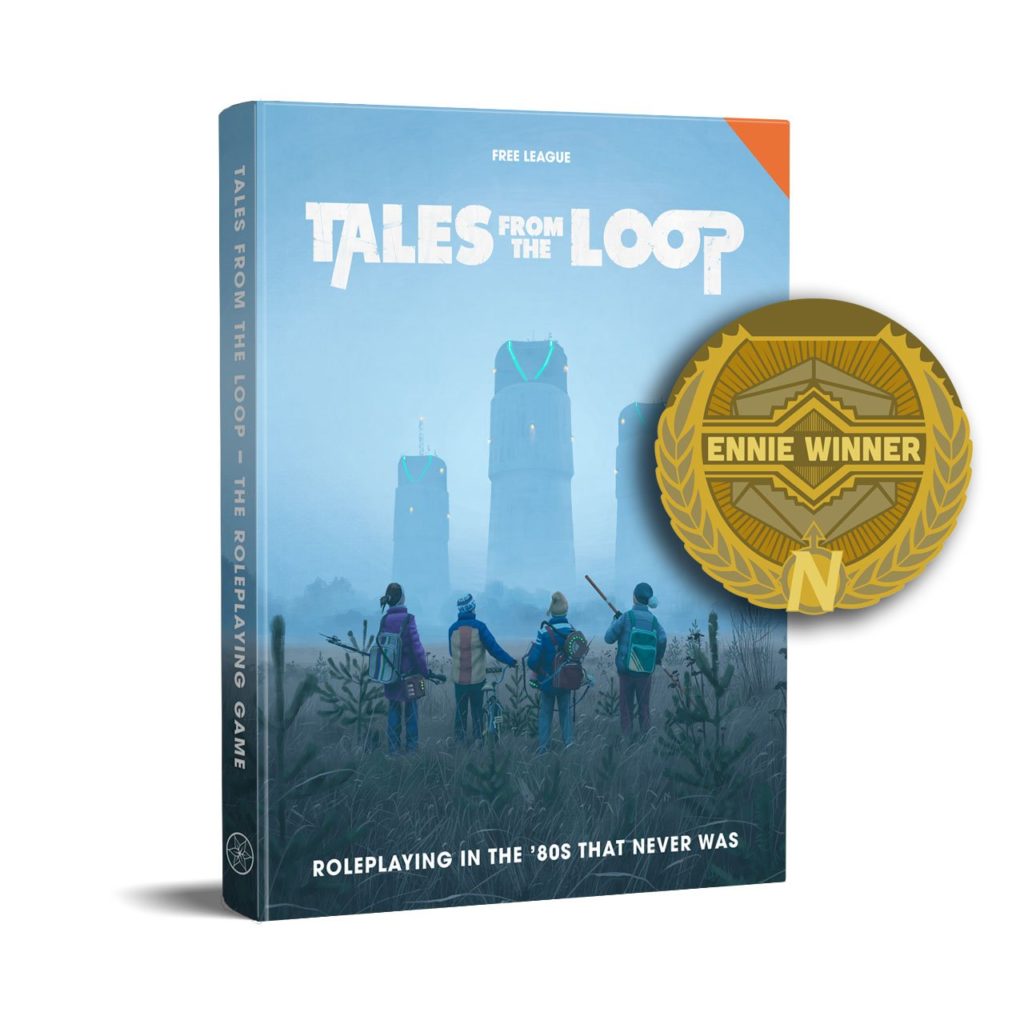Review of Tales from the Loop

This review was written in collaboration with Katrin Schwager of Ludo Liubice e.V. and first published in German. A big thank you to Katrin who also was our Game Master of Tales from the Loop for multiple evenings!
Tales from the Loop is one of those games, which can be explained most easily with a pop culture reference, but with that, the origin is forgotten. Tales from the Loop is a role playing game in the style of Stranger Things. Mysterious things happen in a small town and you play a young character between 10-15 years of age, who is confronted with this mystery together with some friends besides school life and gets to the bottom of it.
What you forget here, however, is that the role play is based on Simon Stålenhags art. It is because of this art that the role-playing game was created, which brings an alternative science-fiction universe in the style of the 80s and benefits from advanced robotics and other technical achievements.
As with the review of Beyond the Wall, we start with an insight into the game system from game master’s perspective. We continue with the opinion from the player’s perspective and end with a conclusion. In this case, Katrin accompanied our teen characters in Boulder City as the game master in our private roleplaying session.

- Publisher: Fria Ligan
- Release Year: 2017
- Language: English
- Format: PDF / Book (Hardcover)
- Price: 23,32 € (PDF) / 39,17 € (Hardcover)
- Available at: Modiphius / Fria Ligan
Interview with the Game Master
How does it feel to lead Tales from the Loop?
Tales from the Loop is the first role-playing game in which I didn’t have to roll the dice as the game master. It was a bit strange at the beginning, but overall I found it very relaxing. Of course, I had to pay more attention to letting the players roll the dice in certain scenes. Especially for this I needed some time in the beginning. Since our teenage heroes practically don’t fight, it’s not so easy to find the balance between them making a skill check for something or not.
Because the world is open, the players have all the possibilities to explore the city. In addition, they can create suitable locations in the city themselves at any time. Personally, I like this way of game mastering and I can adapt to the players very well, because I prefer to play with only some scenario ideas. Here, Tales from the Loop is just right for me. The secret is given, but the ways to get there are quite open for the players. As a game master I also had to adjust to the everyday scenes, like the family dinner or an unplanned shopping visit with the mother. I think everyone can put themselves in the characters’ shoes.
How well is the setting described?
I own the rulebook and the adventure book Our friends the Machines & other Mysteries. I think the graphics by Simon Stålenhag are incredibly great. Only the first 40 pages of the rules deal with the setting and a large part of the description of the 80’s. What distinguishes the 80s in Tales from the Loop from our 80s is personally not described enough for me. I think it would still make sense here to invest in the pure graphic volumes by Simon Stålenhag. But I haven’t got around to that myself yet.
How extensive are the rules?
The rules are really simple, clear and fit the game perfectly. I wrote a one-page summary for my players and we were able to play very well with it. It was relatively easy to look up the rules at the table. From my perspective it made for a fluid game. Personally, I don’t like it when you have to look in the rulebook before taking an action to see what options are open to you because there’s too much choice. But this is certainly a matter of taste.
How helpful is the book for preparation?
It was love at first sight when I took the rules into my hands. The pages are always enhanced by the great graphics, so that I already got the first ideas for scenes in some places. All in all, Tales from the Loop gets along with about 100 pages of settings and rules and describes them very clearly. Also on the rules pages there are almost always examples from concrete game scenes. These made it much easier for me to keep the rules.
Basically I would like to know more about the background of the world. Thus, I would be able to react better to some questions about the technology, especially regarding the robots. During the preparation I listened to the podcast of Austauschhelden.
I think that while playing the book can be used very well. Since I don’t like to look through the book during the session, I actually often write my own summary.
The book already contains small adventures and a small campaign. Also, there is always the option to have the story played in Sweden or the USA.
But my favourite stories are in the adventure book. Here, songs from the 80s were taken as inspiration for scenarios. Especially in combination with the music I got almost endless ideas during the preparation. In the supplementary volume is also the Home Town Hack. It’s a guide to make your own city the playground of the story, as well as construction plans and descriptions of some robots and machines.
Review from a player’s point of view
The Game System
I have not had any experience with the Year Zero engine, which is used as the core of Tales from the Loop, before. The aforementioned questionnaires and cheat-sheets were a good supplement at the table. So we got to the game table and had a questionnaire that guided us through the character creation. While playing, a little summary helped to find out which skill is used for which situation.
Skills, Dice-Pool
It is precisely these skills that are at the heart of the system. In Tales from the Loop, the characters are teenagers and have no hit points. Instead, the protagonists get injured or receive other conditions and are affected by them. This is reflected in the reduced number of dice for skill checks.
A dice roll is made to determine the success of a skill check. So how does this work? Quite simple. There are 4 attributes (Body, Tech, Heart and Mind). In relation to those attributes, there are skills such as Sneak, Tinker, Charm, Investigate and many more. To find out if a test is successful, you roll on a skill. The game system here is set up as a dice-pool. You roll d6 equal to the value of the attribute + the value of the skill. If you roll 6 on one of these dice, you have a simple success. If you roll 2 or more 6s, you have a correspondingly higher success. Some situations may require more than one success, depending on the decision of the game master. This system allows a very fast game.
Consequences and Recovery from Conditions
However, if you do not succeed on a skill check, this will have consequences. Alternatively, you might suffer a condition such as Scared. These states reduce the number of dice by one. Four states in total exist. If you reach all of them, you are Broken and have to recover first. This is done by playing a scene in the hiding place of the young people. Alternatively there is the so-called anchor. The anchor is a special person who is very important to the youth’s character. This could be, for example, the friendly ice cream vendor or comic shop owner. This anchor is also determined in advance. When you play a scene with the anchor, the character recovers accordingly.
Character Creation
Character creation is simple and thematic. So much up front. At the beginning you choose an archetype like the sports ace or the bookworm. These give you certain key skills, among other things. Otherwise you can only invest one point in the skills at the beginning. However, you can invest up to 3 points in the key skills of the archetype.
Next, the age is determined. Here you have the choice between 10 – 15 years. The age decides two things. Firstly, the age indicates how many Luck Points you have. Luck Points are spent, for example, on repeat rolls. Secondly, age decides how many points you can put into your attributes. The number of points for the attributes is 1 to 1 from the age, while the Luck Points are calculated as the difference of 15 – age. You can put 10 points for skills regardless of age.
Iconic Object, Problems, Motivation and Pride
Each character has one iconic item. Something that defines the character more specifically. In my case, my computer geek had a calculator. For checks where you can use this calculator you may roll 2 bonus dice.
Every kid that age had a problem or two. So do our characters. Everyone has to name at least one problem. This can range from divorced parents to unfulfilled love or bullying at school. There are no limits to fantasy or real memories.
As in some other roleplaying systems, something drives a character. The youthful character in Tales from the Loop also needs motivation for a possibly dangerous undertaking. Maybe the character just wants to do the right thing or help his friends?
But just as young people have problems, they develop a certain pride on their way to adulthood. Something that they can do well, that makes them feel good or distinguishes them from others. This pride can lead a one-time trial to automatic success.
Anchors, Relationships and Songs
As mentioned before, there is an anchor person. In addition to this anchor, the relationships to the other player characters and other non-player characters must also be defined. That’s very cool by the way. Because here the players also have a strong influence on the environment of the city and thus the living space of the protagonists. In our group, a pair of siblings emerged among the players who had an alcoholic father and with him their own problems.
The character creation is rounded off by the choice of a favorite song of the time (of course Raining Blood for my well-behaved computer geek from a good family). The character creation ends by determining which hiding place the teenage friends use in their free time.
Setting
The setting is nice and retro. An 80s playlist as ambient music already leads to a suitable mood. Very nice as a player in a bygone era are of course the pop culture references and clichés, which one may and should now take up. Tales from the Loop is set at a time when the first Star Wars trilogy ended, E.T. wanted to phone home and Tom Cruise was an ace pilot. An allusion as well as a quote here and there throws not only player character but also gamers back to that time!
In our case, the game master succeeded very nicely in switching between the detective work of the teenagers, and thus the solving of the mystery, as well as everyday life. Telling your parents why you have to be outside after 6 p.m. is sometimes not that easy and school life also had its pitfalls, as you might like to remember then.
In the first moment it felt very much like our world, but robots or other technology that shouldn’t exist in that time made the world seem quite varied and fresh. Problems like missing mobile phones met farm-robots-agricultural-machinery-things here.
The uncertainty in a role playing game also results in a nice tension curve when something unexplainable happens and the immersion of this fictitious reality breaks. In our case, it was calls from little girls that shouldn’t exist like this, little children on tricycles or data cables that ran to and from places where they didn’t belong.
Conclusion
Katrin
Tales from the Loop is not only convincing at first sight, but has won a permanent place in my role playing heart.
It’s perfect for immersing yourself in a world and our past, which is a bit different. A world without magic, where our heroes are normal teenagers, is a very refreshing approach and makes it easier for both game masters and beginners to get started.
It’s a narrative game, where there are always great situations between the players. It may not be suitable for years of campaigning, but I think you can use it again and again and especially in the time when most of us don’t manage to play regularly anyway, you can play through a story in an evening / afternoon and start a new adventure with the characters a few months later.
René
Tales from the Loop is a great roleplaying game for me as a stopgap or for short campaigns. No years of rounds trying to defeat the epic necromancer, but young people trying to find out what’s going on in the world. One mystery after the other.
As a player, the set of rules is kept very fast and simple. Character creation requires details that not only (might) give the character depth, but also create an interpersonal level with the environment. You create a character that automatically has a life, background and everyday life by rules. In addition, the scenes in the hiding place or with the anchor provide further content for the story. They are created by the player and a possible plot hook for the future.
I think that a simple balancing act of genres like horror and mystery is possible and even appropriate. For all those fans of this kind of game (or series like Stranger Things), Tales from the Loop is definitely an enrichment!








